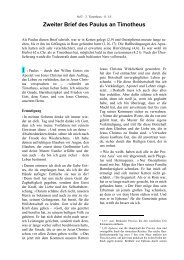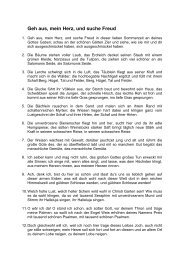Create successful ePaper yourself
Turn your PDF publications into a flip-book with our unique Google optimized e-Paper software.
ually renewed, their half-life being about ten<br />
days. The olfactory cells measure only about 5 to<br />
15 µm (1 µm = one thousandth of a millimetre).<br />
Molecules which cause odours are captured by<br />
the receptors in the mucous membrane of the<br />
nose. The olfactory information is then converted<br />
into electrical impulses which are transmitted to<br />
the so-called olfactory bulb which distributes<br />
them in the brain.<br />
We can distinguish far more than 10,000 different<br />
scents. This wide range can be extended even<br />
further with practice; professional perfume<br />
testers, and coffee and wine tasters excel in this<br />
ability. Only substances that are sufficiently<br />
volatile to emit minute particles into the air can<br />
be smelled. This multitude of odours exceeds the<br />
capacity of our vocabulary to describe them all.<br />
The nose is also essential for respiration. Since<br />
the lungs prefer damp, warm, clear air, air is<br />
moistened and warmed by its long passage over<br />
the mucous membranes of the nose. Most of the<br />
coarser, harmful particles in air are trapped by<br />
the nose’s fine hairs or its thick secretions (mucus).<br />
The olfactory mucous membrane is located fairly<br />
deep inside the nose. It contains millions of<br />
receptor cells embedded in elongated supporting<br />
cells. These sensory nerve cells are stimulated by<br />
odours and also transmit the olfactory messages<br />
directly to the brain. They are “direct intermediaries”<br />
between the outside world and the brain.<br />
From each of their ends, a tuft of fine hairlike<br />
projections called cilia (Latin cilium = eyelash)<br />
extends into the olfactory mucous membrane, in<br />
which the molecules that cause odours are dissolved,<br />
having found their way through the nasal<br />
cavity. These olfactory nerve cells are continuously<br />
renewed from basal neuronal (stem) cells.<br />
This is somewhat exceptional, since many nerve<br />
cells of humans and other organisms are not<br />
replaced when they die.<br />
It has recently been discovered that the number<br />
of detectable odours is directly proportional to<br />
the number of genes. In the case of human<br />
beings (and mammals generally) there are about<br />
1,000 genes which code for the same number of<br />
different olfactory receptors, each of which<br />
occurs in thousands of the millions of sensory<br />
cells. If a mammal has 30,000 genes, then this<br />
means around three percent of them code for<br />
proteins which can bind with odour-causing<br />
molecules. This is the largest group of related<br />
genes discovered so far. It is therefore difficult to<br />
measure various odours objectively, since every<br />
person, apart from identical twins, has his/her<br />
own genetically determined olfactory preferences.<br />
This contrasts sharply with the small number of<br />
optical receptor pigments in the eye. Only three<br />
types of pigments are required to distinguish<br />
between thousands of shades of colour, because<br />
the principle of recognition is fundamentally different:<br />
All three types can receive a wide range<br />
of partially overlapping wave lengths of light,<br />
each being most sensitive in a different part of<br />
the optical spectrum. The brain finally combines<br />
and compares the optical stimuli. Olfactory signals<br />
cannot be handled in a similar way, because<br />
a large number of qualitatively widely different<br />
chemical components would have to be compared.<br />
The process used by the brain to decode olfactory<br />
information is one of the central and most difficult<br />
unsolved problems in neuro-physiology.<br />
The indescribable <strong>sense</strong>: The <strong>sense</strong> of smell truly<br />
is the <strong>sense</strong> beyond words. It can be extraordinarily<br />
exact, but it is practically impossible to<br />
describe a scent to somebody who hasn’t experienced<br />
it personally. We move about 12 cubic<br />
metres (12 m 3 ) of air per day by breathing in and<br />
out 12,000 times. Inhalation requires about<br />
2 seconds, and exhalation 5 seconds. During this<br />
time odour molecules also move with the airflow.<br />
We can describe something we have seen in the<br />
31
















